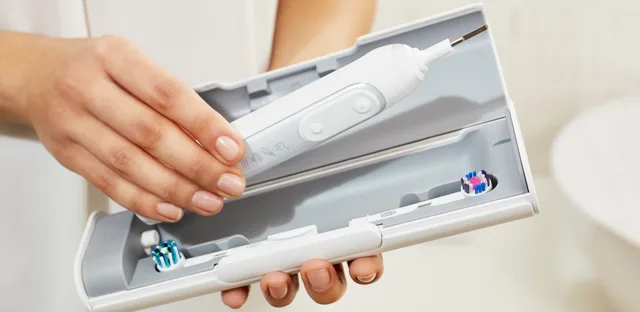Using the correct techniques for twice-daily tooth brushing and flossing will help promote oral health for the long term.
Even if you've been brushing and flossing your teeth since childhood, you may have developed some bad habits over the years, such as brushing too hard, ignoring your back teeth and forgetting to floss.
How to Brush Your Teeth Properly
Keep these general techniques in mind when you brush your teeth, whether before or after flossing. Here’s how to brush your teeth:
Hold your toothbrush at a 45-degree angle toward the gum line.
When brushing your teeth, move the brush back and forth gently, with a circular movement over the front, back and top (chewing surface) of your teeth. Don’t scrub hard along the gum line; you can irritate your gums.
Remember to brush behind your lower (bottom) front teeth. Use the top bristles of the brush to reach this area.
Other elements of complete oral care include brushing your tongue. You'll freshen your breath and eliminate even more cavity-causing bacteria. Also, if you’re at risk for plaque build-up or gum disease, consider adding an antiseptic mouth rinse to your complete oral care routine.
How to Use an Electric Toothbrush
How to Brush Your Teeth with an Electric Toothbrush
When using a rechargeable electric toothbrush, it isn't necessary to press hard or scrub. Simply glide over each tooth and let it do the brushing action. In fact, some electric toothbrushes have pressure sensors that alert you when you’re brushing too hard. Here’s how to brush your teeth with an electric toothbrush:
Step 1: Make sure your toothbrush is charged. Many electric toothbrushes have charge level indicator lights, so you can actually see when the toothbrush is charged.
Step 2: Start with the outside surfaces of the teeth. Glide the brush head slowly from tooth to tooth, holding the brush head in place for a few seconds against each tooth before moving on to the next one. Follow along with the shape of each tooth and the curve of the gums.
Step 3: Repeat Step 2 on the inside surfaces of the teeth.
Step 4: Repeat Step 2 on the chewing surfaces of the teeth as well as behind the back teeth.
Step 5: Direct the brush head along the gum line and upon the gums. Again, do not press hard or scrub.
Step 6: Try grazing the brush head along your tongue and the roof of your mouth, back to front, to help freshen your breath.
With proper brushing technique when using a rechargeable electric toothbrush and a little practice, you’ll be brushing with confidence knowing you’re using the clinically proven technology of a rechargeable electric toothbrush to clean your teeth.
What is a Rechargeable Electric Toothbrush?
A rechargeable electric toothbrush (also known as a “power” toothbrush) can help you do more to maintain the health of your teeth and gums. Many rechargeable toothbrushes use oscillating-rotating technology to provide better oral health results than regular manual toothbrushes. This brushing action is very different from that of regular manual toothbrushes, as it provides the movement, while you need only guide it.
For that reason, some people may find brushing with an electric toothbrush easier once they learn how to do it properly. Just remember that the key to brushing well with an electric toothbrush is to guide the brush head to all parts of your mouth.
How to Brush Your Teeth with a Manual Toothbrush?
Learning how to brush your teeth properly is the first step to maintaining good oral hygiene, healthy teeth and gums. Plus, it helps minimize the risk of tooth decay and gum problems, the major causes of tooth loss.
Before You Begin
While there are several methods of how to brush your teeth with a manual toothbrush, always ask your dental professional for their recommendation and be sure to follow their instructions. To start, use fluoride toothpaste with a soft-bristle toothbrush, and don't forget to replace it every three months.
Two Minutes, Twice a Day
To brush your teeth correctly, spend at least two minutes using a recommended technique, which includes 30 seconds brushing each section of your mouth (upper right, upper left, lower right and lower left), both morning and night. Since most manual toothbrushes don't have built-in two-minute timers, you may want to have a clock handy so you can be sure you're brushing long enough.
Positioning the Toothbrush
How you hold the toothbrush depends on which part of the tooth you're brushing. Here’s how to brush your teeth properly:
Step 1: Start with outer and inner surfaces, and brush at a 45-degree angle in short, half-tooth-wide strokes against the gum line. Make sure you reach your back teeth.
Step 2: Move on to chewing surfaces. Hold the brush flat and brush back and forth along these surfaces.
Step 3: Once you get to the inside surfaces of your front teeth, tilt the brush vertically and use gentle up-and-down strokes with the tip of brush.
Step 4: Be sure to brush your teeth gently along the gum line.
Step 5: Brush your tongue in a back-to-front sweeping motion to remove food particles and help remove odour-causing bacteria to freshen your breath.
Now that you've learned how to brush your teeth, a little discipline in practicing it every day will help make it feel like second nature. It's one of the easiest things you can do to maintain the health of your teeth and gums.
